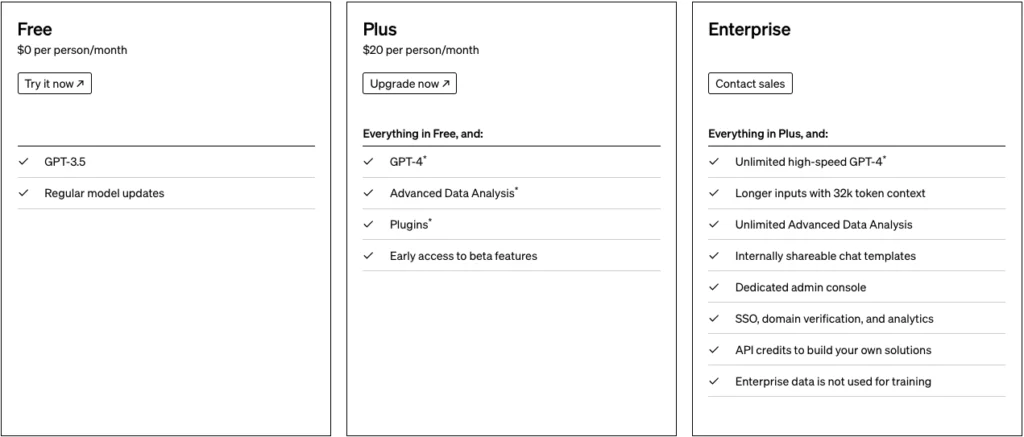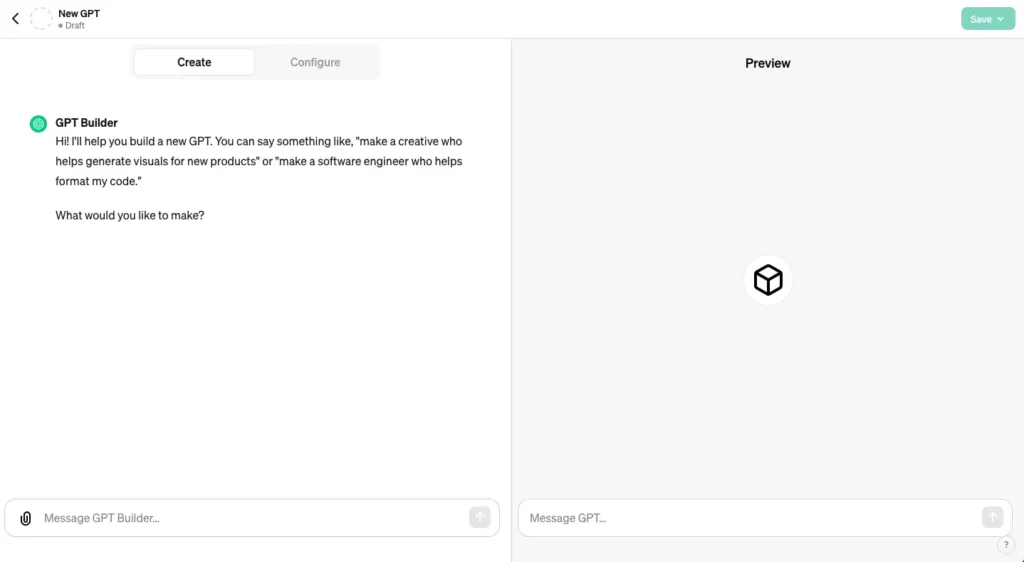Much-anticipated OpenAI GPT store is poised to launch in 2024, marking a pivotal moment for tech enthusiasts and entrepreneurs alike. This innovative platform offers a unique opportunity, especially for those looking to capitalize on the growing trend of AI-driven solutions, without needing extensive coding skills.
The key to success in the Chat GPT store lies in originality. In a marketplace that’s rapidly gaining attention, standing out with a distinctive, innovative GPT model could be your pathway to significant earnings. It’s essential to move swiftly, though. With increasing buzz, the marketplace is likely to attract a wave of similar AI offerings. Establishing your presence early can give you a competitive edge.
We’re here to walk you through every step of creating and monetizing your unique GPT model in this burgeoning digital ecosystem. Alongside these practical tips, we’ll delve into the broader implications of OpenAI’s GPT store and its role in shaping the future of personalized AI technology.
Table of Contents
- What is the OpenAI Custom GPT Store?
- How to make money with your Custom GPT
- Monetize your Custom GPT
- Conclusion

What is the OpenAI Custom GPT Store?
The OpenAI Custom GPT Store is a digital marketplace tailored for Chat GPT Plus and Enterprise customers, offering an unprecedented platform to create, publish, and potentially profit from custom GPT models.
These custom models, crafted using OpenAI’s advanced GPT-4 language model, are set to revolutionize the AI application space. They can serve a myriad of purposes, all within the framework of OpenAI’s usage policies. From aiding in resume creation to more imaginative uses like transforming photographs into animated styles, the possibilities are boundless. This versatility is particularly exciting for those in the SEO and digital marketing space, as it opens up new avenues for content creation and customer engagement.
For entrepreneurs and tech enthusiasts, the Chat GPT Store represents a new frontier. Since the inception of ChatGPT, savvy users have been finding innovative ways to leverage AI for profit. This store streamlines this process, providing a direct route to monetize AI inventions through OpenAI’s ecosystem. However, it’s worth noting that the specifics of the revenue-sharing model or how developers will be compensated have not been fully detailed yet.
On a cautionary note, security concerns have emerged. A security issue identified in November 2023 highlighted the risks associated with the potential unauthorized access to the build code of public custom GPTs. This emphasizes the importance of security considerations when engaging with this new technology.
The GPT Store’s launch comes after a turbulent period in OpenAI’s management, but the anticipation surrounding its opening remains undiminished. For those involved in SEO and digital marketing, this is an opportunity to be at the forefront of AI-driven content and application development, tapping into a market that promises to expand the boundaries of what AI can achieve in various sectors.
In conclusion, the GPT Store is not just a marketplace but a platform for innovation and creativity in the AI space, offering exciting prospects for both developers and users.
How to make money with your Custom GPT
Developing Your Custom GPT: A Step-by-Step Guide

- Choose Your Plan: Before starting to create your custom GPT, you’ll need an account with OpenAI. The ChatGPT Plus plan, priced at $20 per month, is a great starting point. For more advanced needs, consider an Enterprise account, though you’ll need to contact OpenAI’s sales team for specific pricing. Once your account is set up, log in to begin your GPT journey.

- Initiate Your GPT Project: On the OpenAI dashboard, locate and click the “Create a GPT” option. This will bring you to a workspace with a chat interface and various configuration settings. Use the configurations to customize your GPT, and the “playground” area to preview and interact with your model.
- Identify Your Niche: Identifying a unique and profitable niche for your custom GPT model is a key step for its success. This process involves brainstorming and research to discover areas that are either underserved or ripe for innovation. Moreover, integrating your GPT with third-party platforms, like Zapier, can significantly enhance its functionality and appeal. Here’s an elaborated approach:
- Assess Market Needs: Look at current trends and demands in various sectors. For example, a GPT for personalized fitness advice in the health sector, or an interactive historical narrative aid in education.
- Solve a Problem: Identify everyday challenges and conceptualize a GPT solution. This could range from a meal planning assistant to a plant care advisor for gardeners.
- Explore Unique Interests: Target niche hobbies or interests with dedicated communities, such as a GPT that assists in music composition or board game strategy.
- Integrate with Other Technologies: Consider how your GPT could complement existing tech. For instance, a GPT for coding project feedback or integration with home automation systems.
- Add a Creative Twist: Stand out by incorporating creativity or humor, like a humorous recipe generator or a whimsical story creator for children.
- Tap into Emerging Trends: Keep an eye on new trends and needs, such as sustainability advice or virtual travel planning.
- Focus on Personalization: Personalized experiences are always in demand. Consider GPTs that offer personalized shopping advice, styling tips, or educational content.
- Consider Business Needs: For a B2B approach, think of GPTs that assist in business processes like market analysis, customer service automation, or marketing content creation.
- Integration with Third-Party Platforms: Enhance your GPT’s functionality by integrating it with platforms like Zapier. This allows your GPT to connect with hundreds of other apps and services, broadening its use cases. For example, a GPT that helps with task automation by connecting to project management tools or one that sends personalized emails via an email marketing service.
Combining market research, creativity, and understanding potential user needs with smart integrations like Zapier, can help you carve out a unique niche for your GPT model. The success of your GPT will largely depend on how well it meets the specific needs of its intended users and stands out in the marketplace. Integrating with third-party platforms can significantly expand its capabilities and reach, making it more versatile and appealing to a wider audience.
- Naming Your GPT: Choose a name that encapsulates your GPT’s purpose while being catchy and memorable. This name will be your model’s identity in the marketplace.
- Craft Instructions and Examples: Detail is crucial here. Provide clear, concise instructions that guide your GPT in its responses and interactions. Incorporate examples of the type of output you expect from your GPT. These examples help in fine-tuning the model’s performance.
- Testing and Refining: Test your GPT by engaging with it in the Preview area. Challenge it with a variety of questions to assess its capabilities and to identify any areas that need improvement. Refine and tweak the model until you are satisfied with its performance.
For a more detailed guide, you can refer to this comprehensive tutorial on how to create your own custom GPT step by step.

Publishing Your Custom GPT
- Final Review: Before publishing, do a thorough final review. Ensure that all features are working as intended and that the model responds accurately to various inputs.
- Publish or Update: Select the “Publish” option for a new model or “Update” for modifications to an existing one. This step is crucial as it finalizes your changes and prepares the model for sharing.
- Confirmation and Link Generation: After selecting “Publish” or “Update,” a confirmation prompt will appear. Upon confirming, OpenAI will generate a unique link to your GPT model. This link is your key tool for sharing your model with others, whether through social media, email, or other digital platforms.
Making Your GPT Public in the OpenAI Store
- Compliance with OpenAI Policies: Before listing your model in the store, you need to ensure it aligns with OpenAI’s usage policies and brand guidelines. These guidelines are in place to maintain a certain standard and ethical use of the technology.
- Verifying Your Builder Profile: Go to the settings in your OpenAI account, and under the builder profile section, verify your identity. This verification can be done by providing your name or a link to a verified website. This step adds a layer of trust and authenticity to your GPT model.
- Setting Your GPT to Public: After verification, you can change the status of your GPT to “Public.” This makes it visible and accessible in OpenAI’s digital store. The public setting is essential for broader exposure and accessibility, allowing users from all over to discover and interact with your GPT.
- Marketing Your GPT: Once your GPT is public, consider how you will market it to potential users. This could involve creating promotional materials, leveraging social media, engaging in online communities related to your GPT’s niche, or even collaborating with influencers or other creators to boost visibility.
Remember, the success of your GPT model in the OpenAI store not only hinges on its functionality and uniqueness but also on how effectively you can share and promote it. The more visibility your GPT gains, the greater its potential impact and success in the OpenAI ecosystem.
Monetize your Custom GPT
The introduction of your GPT model to OpenAI’s forthcoming GPT store heralds the beginning of a new avenue for passive income. Once your model is live in the store, it becomes a product that users can find, purchase, and even share. This process facilitates a steady stream of income without the need for continuous, active involvement, simplifying the monetization of your creative AI endeavors.
However, mere presence in the GPT store isn’t enough to maximize your model’s potential. Active promotion is key to enhancing its visibility and, consequently, its profitability. Employ strategies like social media marketing, content creation, and engaging with relevant online communities. These efforts are essential in drawing attention to your GPT model, attracting a wider audience, and driving up its usage and revenue. By effectively combining the passive income capabilities of the GPT store with proactive marketing techniques, you can significantly expand the reach and financial success of your custom GPT model.
Content Creation and Monetization
- Diverse Applications: Your custom GPT can be a powerful tool for generating various types of content, from compelling marketing copy and engaging social media posts to informative e-books or articles.
- Tailored Services: If your GPT model offers unique functionalities, consider offering bespoke services. For instance, if your model excels in creating personalized content or unique artistic outputs (such as those generated by DALL-E), you could charge for these specialized services.
- Multi-Faceted Approach: Think beyond the app store. Offering your GPT’s services in different formats or for various applications can open multiple revenue streams. For example, pairing your GPT with freelance services, consultations, or creating subscription-based access to your model’s unique capabilities.
- Community Engagement: Building a community around your GPT model can create long-term value. Engage with users, gather feedback, and continuously improve your offering. A loyal user base can lead to more consistent revenue through repeat use and referrals.
- Marketing and Brand Building:
Marketing and Brand Building
- Personal Branding: Establishing a strong personal or brand identity around your GPT can increase its market appeal. Share stories about the development process, the challenges you’ve overcome, and the unique features of your GPT.
- Collaborations and Partnerships: Explore partnerships with influencers, industry experts, or other platforms to promote your GPT. Collaborations can introduce your GPT to new audiences and add credibility to your offering.
Stay Updated and Innovate
- Keep Learning: The AI landscape is rapidly evolving. Stay informed about the latest trends and updates in AI and GPT technology to keep your model relevant and competitive.
- Iterative Improvements: Regularly update your GPT model based on user feedback and emerging trends. Continuous improvement can lead to a better product, increasing its value and appeal in the marketplace.
Monetizing your custom GPT involves a mix of leveraging available platforms like the GPT store, creatively using the GPT for content generation, actively marketing your model, and continuously innovating to stay ahead in a dynamic market. With the right strategy and a unique idea, your custom GPT can become a profitable part of your digital toolkit.
Conclusion
In conclusion, the journey of creating and monetizing a custom GPT model in OpenAI GPT store is both an exciting and potentially lucrative endeavor. It combines the thrill of innovation with the practicality of earning a passive income. By strategically leveraging the store’s platform for visibility and utilizing proactive marketing, your unique GPT creation can reach a wide audience and become a valuable asset in the digital marketplace.
On a personal note, I recall a friend who ventured into this realm. They developed a GPT model tailored for travel enthusiasts, offering bespoke itineraries and local tips. Initially, they faced challenges in gaining traction. However, by actively promoting their GPT through travel blogs and social media, they managed to cultivate a dedicated following. This not only boosted their model’s usage but also opened doors to partnerships with travel agencies. Their experience is a testament to the power of a well-crafted GPT model combined with effective promotion, transforming a simple idea into a thriving digital product.
Your journey with GPT may have its challenges, but with creativity, dedication, and strategic marketing, it can be an enriching and rewarding experience. The world of AI is full of possibilities, and your custom GPT could very well be the next big thing in this ever-evolving landscape.